light PORSCHE CAYNNE 2008 1.G Information Manual
[x] Cancel search | Manufacturer: PORSCHE, Model Year: 2008, Model line: CAYENNE, Model: PORSCHE CAYENNE 2008 1.GPages: 95, PDF Size: 3.37 MB
Page 46 of 95

piston units at the rear. The
resulting brake forces are not
only high, they are also extremely
Porsche Ceramic Composite Brake (PCCB).
Porsche Ceramic Composite Brake (PCCB),
front disc diameter: 410 mm
The pads are mounted in six-
piston monobloc aluminium fixed
calipers at the front, with four-
Safety
As an optional alternative, the
Cayenne S, Cayenne GTS and
Cayenne Turbo can all be
equipped with the race-proven
Porsche Ceramic Composite
Brake (PCCB)*.
The large disc diameter (410 mm
front and 370 mm rear) adds
significantly to brake performance.
The discs are made from a
specially treated carbon-fibre
compound that is silicated in a
high-vacuum process at 1,700 ºC.
The resulting material is not only
much harder than cast iron, it
is also more resistant to heat.
Even at high temperatures, the
thermal resistance of the PCCB
disc ensures excellent dimensional
stability. The ceramic material is
totally resistant to corrosion and
offers excellent acoustic damping
properties.consistent. The pedal response
is fast and precise with only
moderate input required.
PCCB enables shorter braking
distances in even the toughest
road and race conditions.
Excellent fade resistance ensures
greater balance when slowing
from high speed.
· 97 · · 96 ·
The Porsche Ceramic Composite
Brake (PCCB) is a visible
acknowledgement of Porsche race
engineering. The key advantage
is a total weight saving of
approximately 50 % compared
with equivalent cast-iron discs.
As well as enhancing performance,
the unsprung and rotating masses
are lightened. The results: greater
comfort and road-holding
on uneven road surfaces plus
better handling and agility.
* Compatible with 20-inch wheel diameter or greater as well as 19-inch collapsible spare wheel.
Page 47 of 95

Oversteer with PSM
Understeer without PSM
Car steers
off line Car steers
off line PSM corrects
line and
stabilises car
PSM corrects
line and
stabilises car
Understeer with PSM Oversteer without PSM
All Cayenne models are
equipped with Porsche Stability
Management (PSM) as standard.
This electronic control system
uses a range of functions –
including anti-lock braking (ABS) –
to help stabilise the vehicle
(and trailer, if fitted) in hazardous
road scenarios. Throughout each
journey, PSM uses a range of
sensors to monitor the direction,
speed, yaw velocity (speed of
rotation around the vertical axis)
and lateral acceleration of the
car. The system then calculates
the actual direction of travel. If
the car begins to oversteer or
understeer, PSM applies selective
braking on individual wheels to
restore stability. If necessary,
PSM can also intervene in the
engine management system to
temporarily modify the amount
of drive to the wheels.PSM has two additional functions
that help reduce braking distances.
If the throttle pedal is released
suddenly, PSM automatically
readies the braking system. The
pressure in the brake lines is
marginally increased, bringing
each of the pads into light contact
with the corresponding disc. If the
driver goes on to apply the brakes,
the calipers respond more quickly.
In an emergency stop – i.e., when
the pressure on the brake pedal
exceeds a certain threshold –
the brake assist function uses
the PSM hydraulics to apply
maximum braking force at all
four wheels.
PSM makes a significant contribu-
tion to car and trailer safety –
within the laws of physics. It
compensates for load transfer
caused by throttle and brake
inputs up to the maximum degree
of lateral acceleration. It also
enhances the car’s driving dynam-
ics and directional stability when
accelerating on variable road
surfaces. PSM can also intervene
through the locking centre and
axle differentials as part of
Porsche Traction Management
(PTM).
Other features include a
special control strategy in
the PSM-integrated ABS for braking on loose surfaces such
as gravel or snow. By briefly
locking the wheels, a wedge is
formed ahead of each tyre which
provides additional purchase
to help slow the car.
For a more active driving experi-
ence, PSM can also be disabled.
For safety reasons, it remains
active in the background, ready
to intervene in critical scenarios.
Expecting the best means preparing for the worst.
Porsche Stability Management (PSM).
Safety
· 99 · · 98 ·
Page 48 of 95
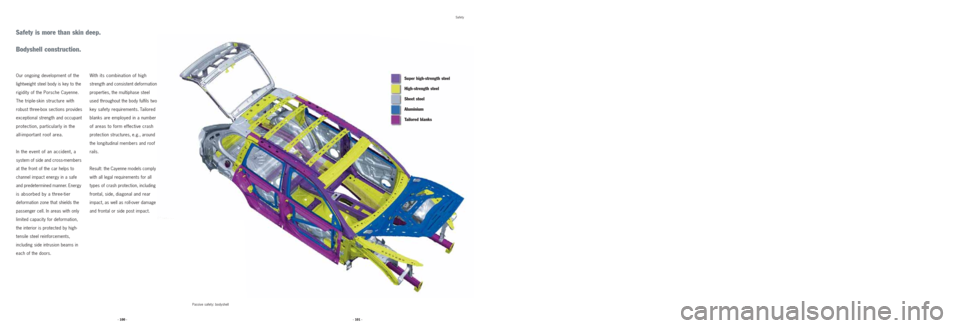
Our ongoing development of the
lightweight steel body is key to the
rigidity of the Porsche Cayenne.
The triple-skin structure with
robust three-box sections provides
exceptional strength and occupant
protection, particularly in the
all-important roof area.
In the event of an accident, a
system of side and cross-members
at the front of the car helps to
channel impact energy in a safe
and predetermined manner. Energy
is absorbed by a three-tier
deformation zone that shields the
passenger
cell. In areas with only
limited capacity for deformation,
the interior is protected by high-
tensile steel reinforcements,
including side intrusion beams in
each of the doors.
Safety is more than skin deep.
Bodyshell construction.
Safety
With its combination of high
strength and consistent deformation
properties, the multiphase steel
used throughout the body fulfils two
key safety requirements. Tailored
blanks are employed in a number
of areas to form effective crash
protection structures, e.g., around
the longitudinal members and roof
rails.
Result: the Cayenne models comply
with all legal requirements for all
types of crash protection, including
frontal, side, diagonal and rear
impact, as well as roll-over damage
and frontal or side post impact.Super high-strength steel
High-strength steel
Sheet steel
Aluminium
Tailored blanks
· 101 · · 100 ·Passive safety: bodyshell
Page 49 of 95
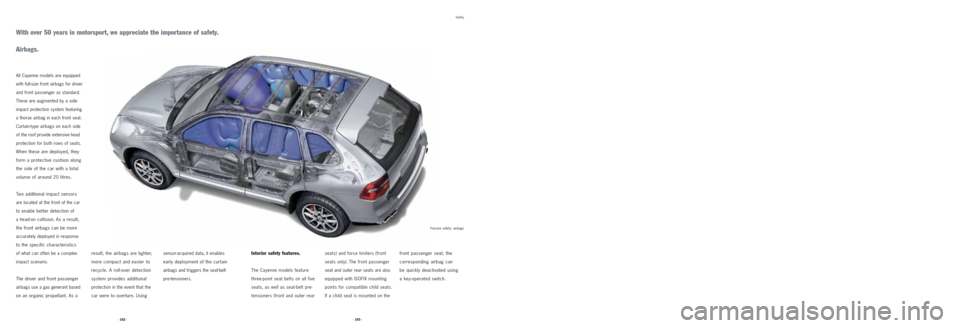
With over 50 years in motorsport, we appreciate the importance of safety.
Airbags.
All Cayenne models are equipped
with full-size front airbags for driver
and front passenger as standard.
These are augmented by a side-
impact protection system featuring
a thorax airbag in each front seat.
Curtain-type airbags on each side
of the roof provide extensive head
protection for both rows of seats.
When these are deployed, they
form a protective cushion along
the side of the car with a total
volume of around 20 litres.
Two additional impact sensors
are located at the front of the car
to enable better detection of
a head-on collision. As a result,
the front airbags can be more
accurately deployed in response
to the specific characteristics
of what can often be a complex
impact scenario.
The driver and front passenger
airbags use a gas generant based
on an organic propellant. As aresult, the airbags are lighter,
more compact and easier to
recycle. A roll-over detection
system provides additional
protection in the event that the
car were to overturn. Using
sensor-acquired data, it enables
early deployment of the curtain
airbags and triggers the seat-belt
pre-tensioners.
Interior safety features.
The Cayenne models feature
three-point seat belts on all five
seats, as well as seat-belt pre-
tensioners (front and outer rearseats) and force limiters (front
seats only). The front passengerseat and outer rear seats are also
equipped with ISOFIX mounting
points for compatible child seats.
If a child seat is mounted on the
front passenger seat, the
corresponding airbag can
be quickly deactivated using
a key-operated switch.
Safety
· 103 · · 102 ·Passive safety: airbags
Page 52 of 95
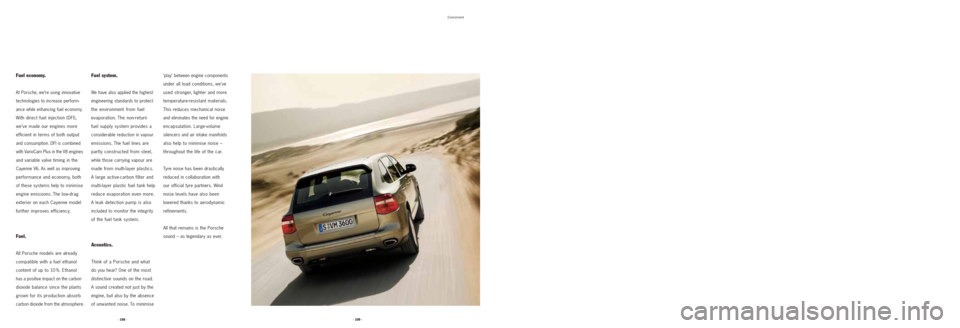
Environment
Fuel system.
We have also applied the highest
engineering standards to protect
the environment from fuel
evaporation. The non-return
fuel supply system provides a
considerable reduction in vapour
emissions. The fuel lines are
partly constructed from steel,
while those carrying vapour are
made from multi-layer plastics.
A large active-carbon filter and
multi-layer plastic fuel tank help
reduce evaporation even more.
A leak detection pump is also
included to monitor the integrity
of the fuel tank system.
Acoustics.
Think of a Porsche and what
do you hear? One of the most
distinctive sounds on the road.
A sound created not just by the
engine, but also by the absence
of unwanted noise. To minimise
Fuel economy.
At Porsche, we’re using innovative
technologies to increase perform-
ance while enhancing fuel economy.
With direct fuel injection (DFI),
we’ve made our engines more
efficient in terms of both output
and consumption. DFI is combined
with VarioCam Plus in the V8 engines
and variable valve timing in the
Cayenne V6. As well as improving
performance and economy, both
of these systems help to minimise
engine emissions. The low-drag
exterior on each Cayenne model
further improves efficiency.
Fuel.
All Porsche models are already
compatible with a fuel ethanol
content of up to 10 %. Ethanol
has a positive impact on the carbon
dioxide balance since the plants
grown for its production absorb
carbon dioxide from the atmosphere.
‘play’ between engine components
under all load conditions, we’ve
used stronger, lighter and more
temperature-resistant materials.
This reduces mechanical noise
and eliminates the need for engine
encapsulation. Large-volume
silencers and air intake manifolds
also help to minimise noise –
throughout the life of the car.
Tyre noise has been drastically
reduced in collaboration with
our official tyre partners. Wind
noise levels have also been
lowered thanks to aerodynamic
refinements.
All that remains is the Porsche
sound – as legendary as ever.
· 109 · · 108 ·
Page 53 of 95

Environment
Servicing.
Although every journey is a pleasure
in a Porsche, there’s one you won’t
have to make too often. Thanks to
the lengthy service intervals and
long-life components, we may not
be seeing you for some time.
In the case of the oil filter, for
example, all that’s replaced is an
easily recyclable paper element.
The oil filter casing remains on
the car.
All moving parts inside the engine
are fully self-adjusting. The valve
clearances, for example, feature
automatic hydraulic control.
All camshafts have a zero-
maintenance chain-drive system.With single-spark coils on each
of the cylinders, the entire ignition
system, with the exception of the
spark plugs, is maintenance-free.
These modest servicing require-
ments mean less waste disposal
and fewer demands on natural
resources. They also lower the
cost of ownership while keeping
your car on the road.
Service intervals for the Cayenne
models are dependent on a range
of factors, including local fuel
quality. For full details of service
intervals in your country/region,
please consult the relevant price
list or contact your Porsche Centre.
Materials and recycling.
Owning a Porsche should be a
lasting pleasure with minimal
impact on the environment. That’s
why every Porsche is built to
endure both technically and in
terms of design. The lightweight
exhaust on the Cayenne models,
for example, is constructed from
long-life stainless steel.
Weight reduction is a fundamental
part of the Porsche design philoso-
phy. By using a greater proportion
of high-strength materials, e.g.,
special steels, cast aluminium
alloys and synthetic materials, we
have successfully reduced the
weight of each car and therefore
its fuel consumption. Every produc-
tion process we use at Porsche
is designed with the environment
in mind. Also, every Porsche model
is
entirely free of asbestos, CFCs
and
components manufacturedusing
CFCs. All legal requirements
in respect of recycling are fulfilled.
Materials are labelled in accordance
with VDA 260, enabling better
recycling of end-of-life vehicles and
individual parts and assemblies.
While more than 85 % of the car
can be recycled using current
technologies, the chances are
your new Cayenne may never need
recycling at all. After all, two thirds
of all the cars we have ever made
are still on the road today.
· 111 · · 110 ·
Page 58 of 95
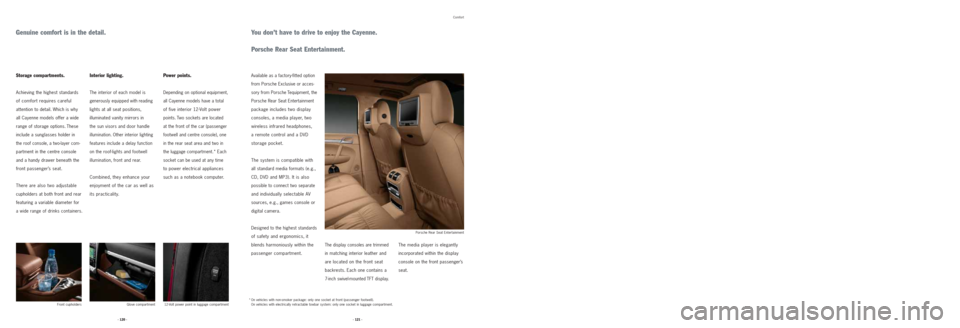
Storage compartments.
Achieving the highest standards
of comfort requires careful
attention to detail. Which is why
all Cayenne models offer a wide
range of storage options. These
include a sunglasses holder in
the roof console, a two-layer com-
partment in the centre console
and a handy drawer beneath the
front passenger’s seat.
There are also two adjustable
cupholders at both front and rear
featuring a variable diameter for
a wide range of drinks containers.
Interior lighting.
The interior of each model is
generously equipped with reading
lights at all seat positions,
illuminated vanity mirrors in
the sun visors and door handle
illumination. Other interior lighting
features include a delay function
on the roof-lights and footwell
illumination, front and rear.
Combined, they enhance your
enjoyment of the car as well as
its practicality.
Power points.
Depending on optional equipment,
all Cayenne models have a total
of five interior 12-Volt power
points. Two sockets are located
at the front of the car (passenger
footwell and centre console), one
in the rear seat area and two in
the luggage compartment.* Each
socket can be used at any time
to power electrical appliances
such as a notebook computer.
Available as a factory-fitted option
from Porsche Exclusive or acces-
sory from Porsche Tequipment, the
Porsche Rear Seat Entertainment
package includes two display
consoles, a media player, two
wireless infrared headphones,
a remote control and a DVD
storage pocket.
The system is compatible with
all standard media formats (e.g.,
CD, DVD and MP3). It is also
possible to connect two separate
and individually selectable AV
sources, e.g., games console or
digital camera.
Designed to the highest standards
of safety and ergonomics, it
blends harmoniously within the
passenger compartment.
The display consoles are trimmed
in matching interior leather and
are located on the front seat
backrests. Each one contains a
7-inch swivel-mounted TFT display.
The media player is elegantly
incorporated within the display
console on the front passenger’s
seat.
Front cupholders Glove compartment 12-Volt power point in luggage compartment Porsche Rear Seat Entertainment
Comfort
Genuine comfort is in the detail. You don’t have to drive to enjoy the Cayenne.
Porsche Rear Seat Entertainment.
· 121 · · 120 ·* On vehicles with non-smoker package: only one socket at front (passenger footwell).
On vehicles with electrically retractable towbar system: only one socket in luggage compartment.
Page 60 of 95
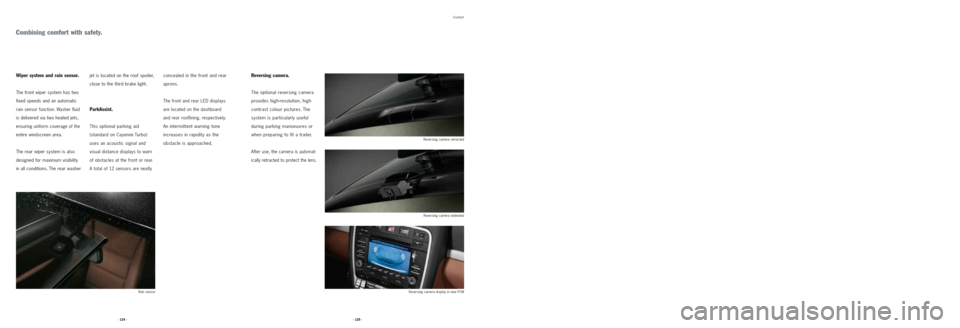
Wiper system and rain sensor.
The front wiper system has two
fixed speeds and an automatic
rain sensor function. Washer fluid
is delivered via two heated jets,
ensuring uniform coverage of the
entire windscreen area.
The rear wiper system is also
designed for maximum visibility
in all conditions. The rear washerjet is located on the roof spoiler,
close to the third brake light.
ParkAssist.
This optional parking aid
(standard on Cayenne Turbo)
uses an acoustic signal and
visual distance displays to warn
of obstacles at the front or rear.
A total of 12 sensors are neatly
concealed in the front and rear
aprons.
The front and rear LED displays
are located on the dashboard
and rear rooflining, respectively.
An intermittent warning tone
increases in rapidity as the
obstacle is approached.
Reversing camera.
The optional reversing camera
provides high-resolution, high-
contrast colour pictures. The
system is particularly useful
during parking manoeuvres or
when preparing to fit a trailer.
After use, the camera is automat-
ically retracted to protect the lens.
Rain sensorReversing camera retracted
Reversing camera display in new PCM
Combining comfort with safety.
Comfort
Reversing camera extended
· 125 · · 124 ·
Page 61 of 95

Comfort, ergonomics and security.
Anti-theft protection.
The Cayenne models are all
equipped as standard with an
engine immobiliser and anti-theft
alarm featuring ultrasonic interior
surveillance.
The alarm circuit includes all four
doors, engine lid, tailgate, rear
screen, interior, ignition and trailer
(if fitted).
The immobiliser system works by
automatically communicating with
the vehicle key. If the key is ap-
proved, the engine can be started
as normal.
When the key is removed from the
ignition, the steering column is
automatically locked to provide
additional security.
Porsche Entry & Drive.
With this optional system, you can
reduce the inconvenience of a con-
ventional key.
The moment you touch the door
handle
, the system automatically
checks the encrypted access code
on the key in your pocket. If the
code is accepted, the doors are
unlocked. To start or stop the
engine, simply push the ignition
button.
To lock the car on leaving, all you
have to do is press a button on the
outside of the door handle. Porsche
Entry & Drive then secures the car
doors, arms the immobiliser and
locks the steering column.
Preparation for vehicle
tracking system.
This optional preparation available
for all Cayenne models enables
future installation of a vehicle
tracking system obtainable from
Porsche Tequipment. The system
can be used to locate a stolen
vehicle across much of Europe.
Includes special wiring loom,
higher capacity battery (depend-
ing on vehicle specification) and
tilt sensor for the alarm system.
Cruise control.
Standard on the Cayenne Turbo
and optional on all other models,
cruise control offers increased
comfort on long-distance journeys.
It can be used at speeds between
30 and 240 km / h (19 and 149 mph)
and is activated using a button on
one of the control stalks.
Slide /tilt sunroof.
Available as an option on all
Cayenne models, the slide/tilt
sunroof is made from tinted
single-pane safety glass and has
a manually adjustable sunscreen.
The roof position is easily adjusted
using a single illuminated rotary
control. The sunroof also has
an anti-jam facility, as do all the
electric windows.
Comfort lighting package.
One of the special features in this
optional package is the ‘Welcome
Home’ lighting function. When you
arrive at a destination after dark,
the headlights remain
illuminated
Comfort
for a user-defined period, lighting
your path from the car. Other
features include courtesy lights
on both exterior
mirrors, auto-
matic headlight activation and
automatically dimming interior
and exterior mirrors.
· 127 · · 126 ·
Page 62 of 95

Explore the world.
In every direction.
Panoramic roof system.
The electrically operated
panoramic roof system is available
as an option on all Cayenne models.
Made from laminated safety glass,
it has a total surface area of
approximately 1.4 square metres –
almost four times larger than the
optional slide/tilt sunroof. Even
when closed, it provides a unique
‘open-top’ driving experience. The
panoramic view can be enjoyed
from all seat positions in every
type of weather.
A key advantage of the panoramic
roof system is its variability. The
roof consists of three movable
segments (1 – 3) and one fixedsegment (4). When the roof is
opened, the forward segment (1)
tilts upwards to act as a wind
deflector. Even at high speed
it helps reduce turbulence and
noise. The two middle segments
(2 and 3) can be opened
separately to provide a stream
of fresh air to the front or rear.For the ultimate open-top driving
experience, both central segments
can be fully retracted to the rear.
It is also possible to tilt segment
3 (above rear seats) to provide
additional ventilation. In all, there
are 15 roof settings to choose
from.
An electrically operated sunscreen
protects the interior against direct
sunlight.
The roof settings are
selected using a single illuminated
rotary control located on the roof
console. When the car is stationary,
it can also be operated using the
ignition key in the door lock.
Comfort
Panoramic roof system opened fullyPanoramic roof system closed
Panoramic roof system opened at rear
43 2 1
43 2 1
43 2 1
· 129 · · 128 ·